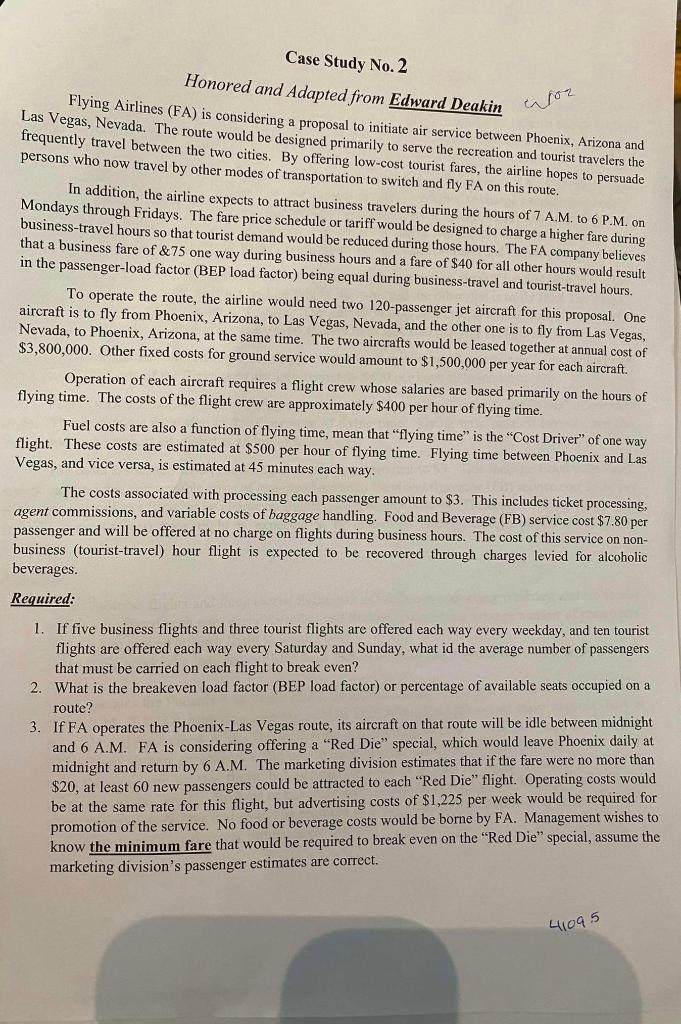
Case Study No. 2 Honored and Adapted from EdwardDeakin Flying Airlines (FA) is considering a proposal to initiate air service between Phoenix, Arizona and Las Vegas, Nevada. The route would be designed primarily to serve the recreation and tourist travelers the frequently travel between the two cities. By offering low-cost tourist fares, the airline hopes to persuade persons who now travel by other modes of transportation to switch and fly FA on this route. In addition, the airline expects to attract business travelers during the hours of 7 A.M. to 6 P.M. on Mondays through Fridays. The fare price schedule or tariff would be designed to charge a higher fare during business-travel hours so that tourist demand would be reduced during those hours. The FA company believes that a business fare of &75 one way during business hours and a fare of $40 for all other hours would result in the passenger-load factor (BEP load factor) being equal during business-travel and tourist-travel hours. To operate the route, the airline would need two 120-passenger jet aircraft for this proposal. One aircraft is to fly from Phoenix, Arizona, to Las Vegas, Nevada, and the other one is to fly from Las Vegas, Nevada, to Phoenix, Arizona, at the same time. The two aircrafts would be leased together at annual cost of $3,800,000. Other fixed costs for ground service would amount to $1,500,000 per year for each aircraft. Operation of each aircraft requires a flight crew whose salaries are based primarily on the hours of flying time. The costs of the flight crew are approximately $400 per hour of flying time. Fuel costs are also a function of flying time, mean that "flying time" is the "Cost Driver" of one way flight. These costs are estimated at $500 per hour of flying time. Flying time between Phoenix and Las Vegas, and vice versa, is estimated at 45 minutes each way. The costs associated with processing each passenger amount to $3. This includes ticket processing, agent commissions, and variable costs of baggage handling. Food and Beverage (FB) service cost $7.80 per passenger and will be offered at no charge on flights during business hours. The cost of this service on nonbusiness (tourist-travel) hour flight is expected to be recovered through charges levied for alcoholic beverages. Required: 1. If five business flights and three tourist flights are offered each way every weekday, and ten tourist flights are offered each way every Saturday and Sunday, what id the average number of passengers that must be carried on each flight to break even? 2. What is the breakeven load factor (BEP load factor) or percentage of available seats occupied on a route? 3. If FA operates the Phoenix-Las Vegas route, its aircraft on that route will be idle between midnight and 6 A.M. FA is considering offering a "Red Die" special, which would leave Phoenix daily at midnight and return by 6 A.M. The marketing division estimates that if the fare were no more than $20, at least 60 new passengers could be attracted to each "Red Die" flight. Operating costs would be at the same rate for this flight, but advertising costs of $1,225 per week would be required for promotion of the service. No food or beverage costs would be borne by FA. Management wishes to know the minimum fare that would be required to break even on the "Red Die" special, assume the marketing division's passenger estimates are correct. Case Study No. 2 Honored and Adapted from EdwardDeakin Flying Airlines (FA) is considering a proposal to initiate air service between Phoenix, Arizona and Las Vegas, Nevada. The route would be designed primarily to serve the recreation and tourist travelers the frequently travel between the two cities. By offering low-cost tourist fares, the airline hopes to persuade persons who now travel by other modes of transportation to switch and fly FA on this route. In addition, the airline expects to attract business travelers during the hours of 7 A.M. to 6 P.M. on Mondays through Fridays. The fare price schedule or tariff would be designed to charge a higher fare during business-travel hours so that tourist demand would be reduced during those hours. The FA company believes that a business fare of &75 one way during business hours and a fare of $40 for all other hours would result in the passenger-load factor (BEP load factor) being equal during business-travel and tourist-travel hours. To operate the route, the airline would need two 120-passenger jet aircraft for this proposal. One aircraft is to fly from Phoenix, Arizona, to Las Vegas, Nevada, and the other one is to fly from Las Vegas, Nevada, to Phoenix, Arizona, at the same time. The two aircrafts would be leased together at annual cost of $3,800,000. Other fixed costs for ground service would amount to $1,500,000 per year for each aircraft. Operation of each aircraft requires a flight crew whose salaries are based primarily on the hours of flying time. The costs of the flight crew are approximately $400 per hour of flying time. Fuel costs are also a function of flying time, mean that "flying time" is the "Cost Driver" of one way flight. These costs are estimated at $500 per hour of flying time. Flying time between Phoenix and Las Vegas, and vice versa, is estimated at 45 minutes each way. The costs associated with processing each passenger amount to $3. This includes ticket processing, agent commissions, and variable costs of baggage handling. Food and Beverage (FB) service cost $7.80 per passenger and will be offered at no charge on flights during business hours. The cost of this service on nonbusiness (tourist-travel) hour flight is expected to be recovered through charges levied for alcoholic beverages. Required: 1. If five business flights and three tourist flights are offered each way every weekday, and ten tourist flights are offered each way every Saturday and Sunday, what id the average number of passengers that must be carried on each flight to break even? 2. What is the breakeven load factor (BEP load factor) or percentage of available seats occupied on a route? 3. If FA operates the Phoenix-Las Vegas route, its aircraft on that route will be idle between midnight and 6 A.M. FA is considering offering a "Red Die" special, which would leave Phoenix daily at midnight and return by 6 A.M. The marketing division estimates that if the fare were no more than $20, at least 60 new passengers could be attracted to each "Red Die" flight. Operating costs would be at the same rate for this flight, but advertising costs of $1,225 per week would be required for promotion of the service. No food or beverage costs would be borne by FA. Management wishes to know the minimum fare that would be required to break even on the "Red Die" special, assume the marketing division's passenger estimates are correct







